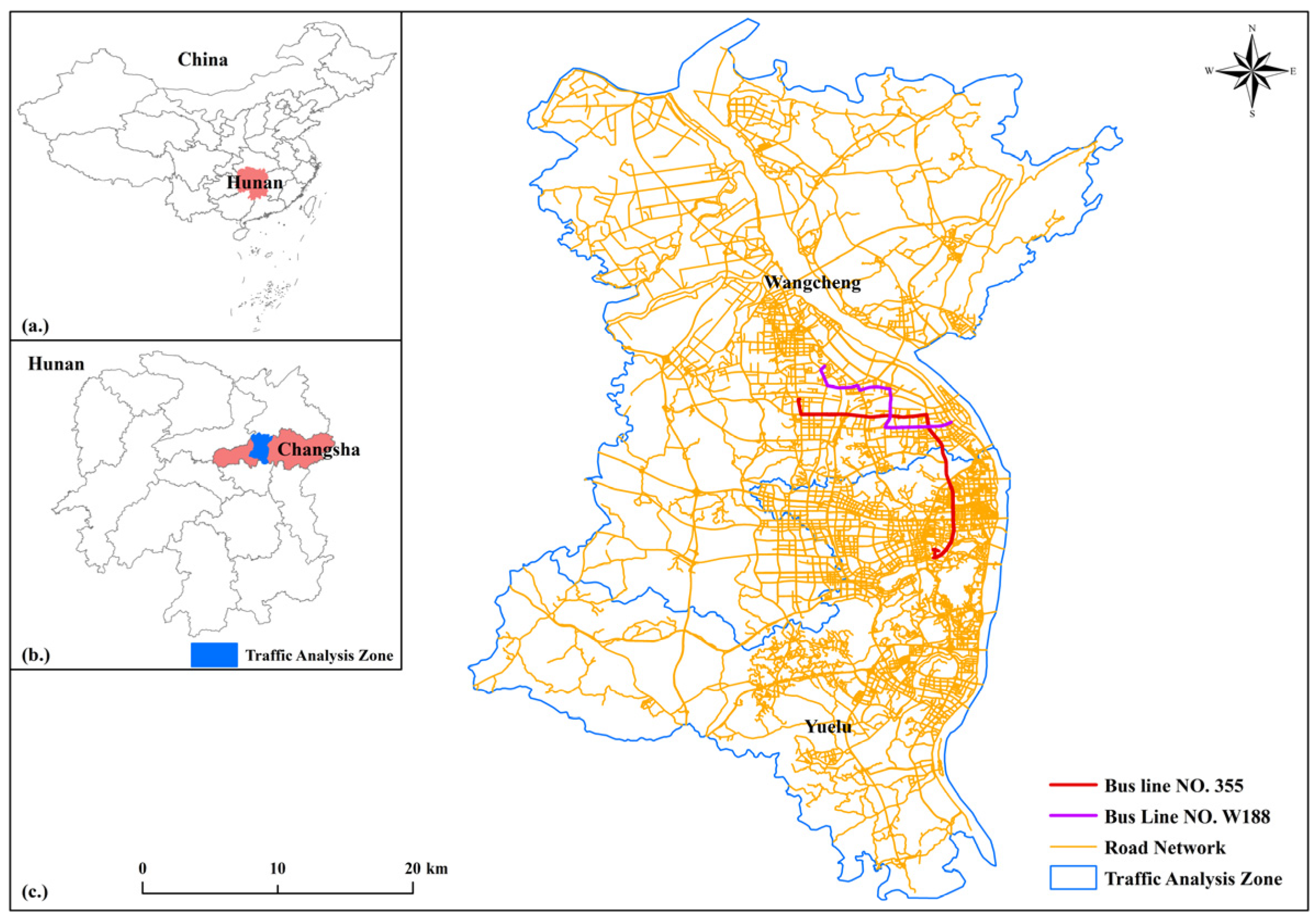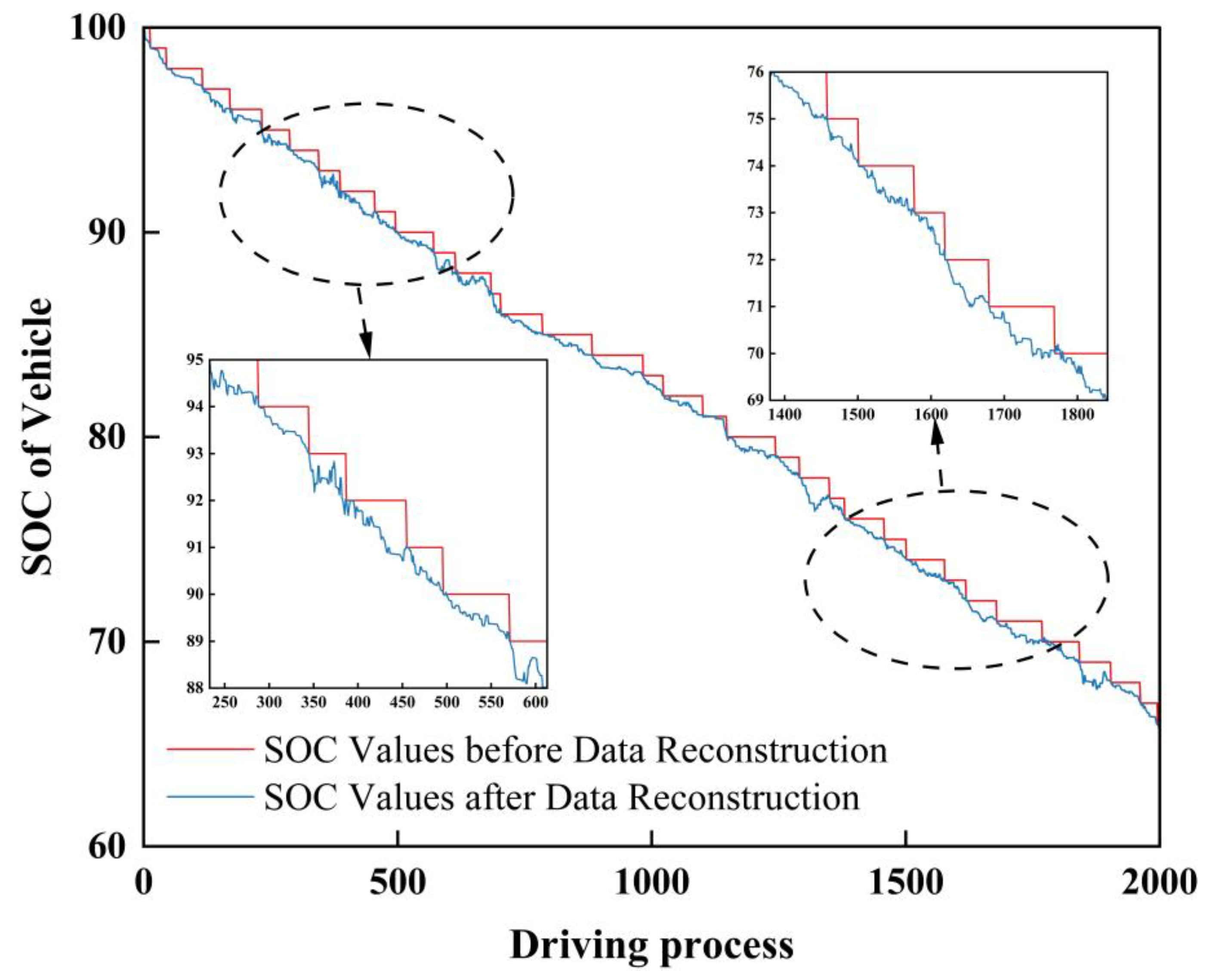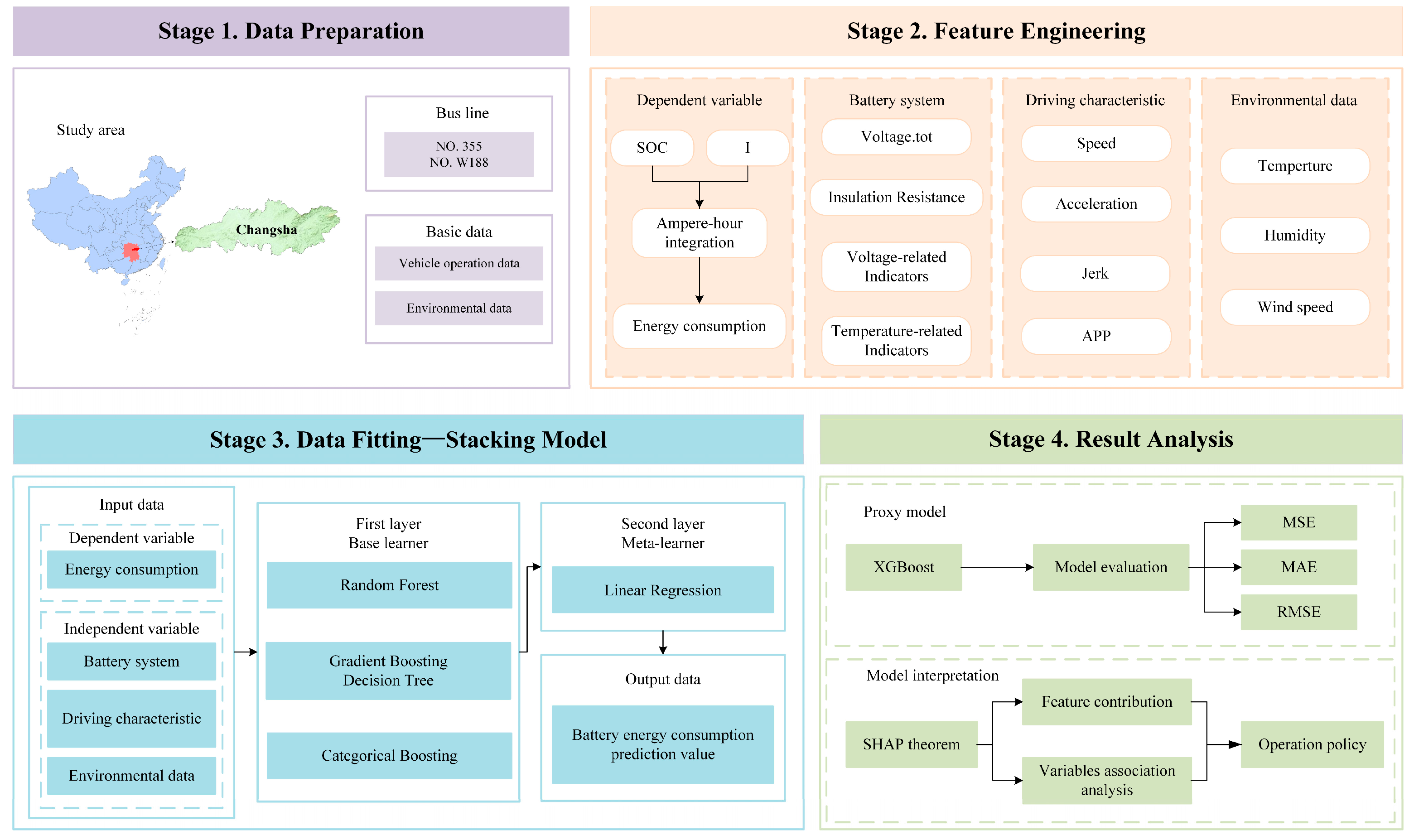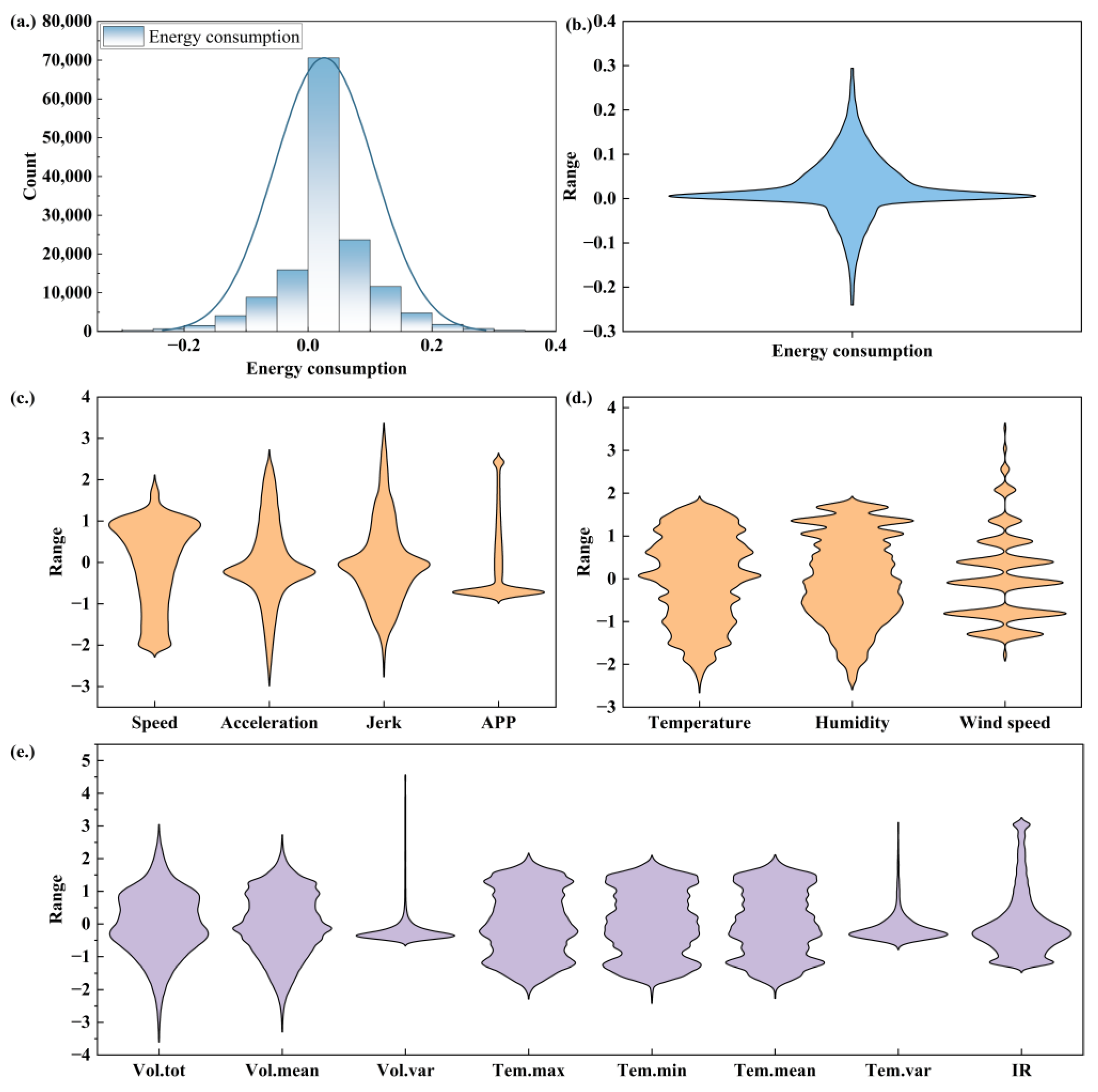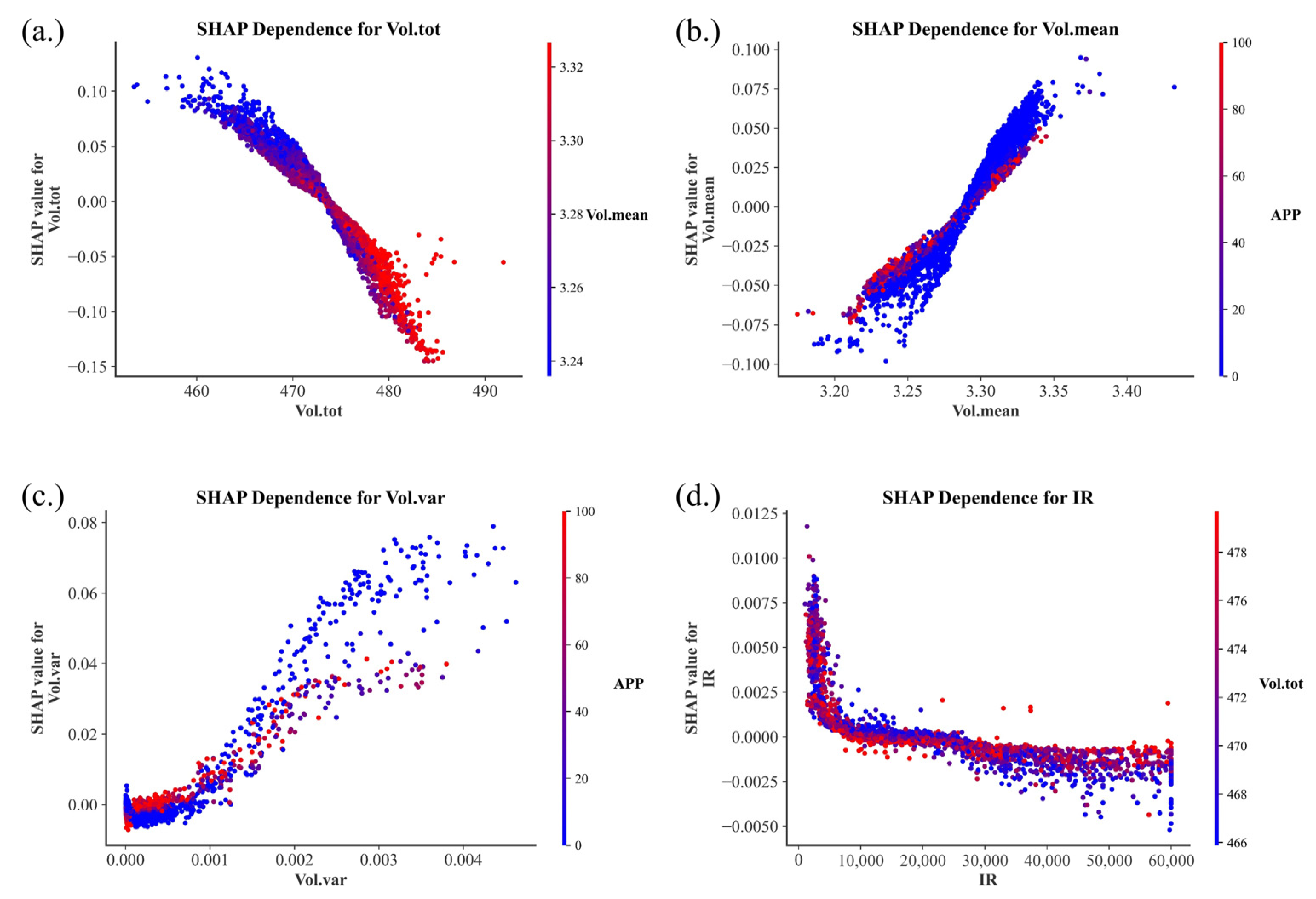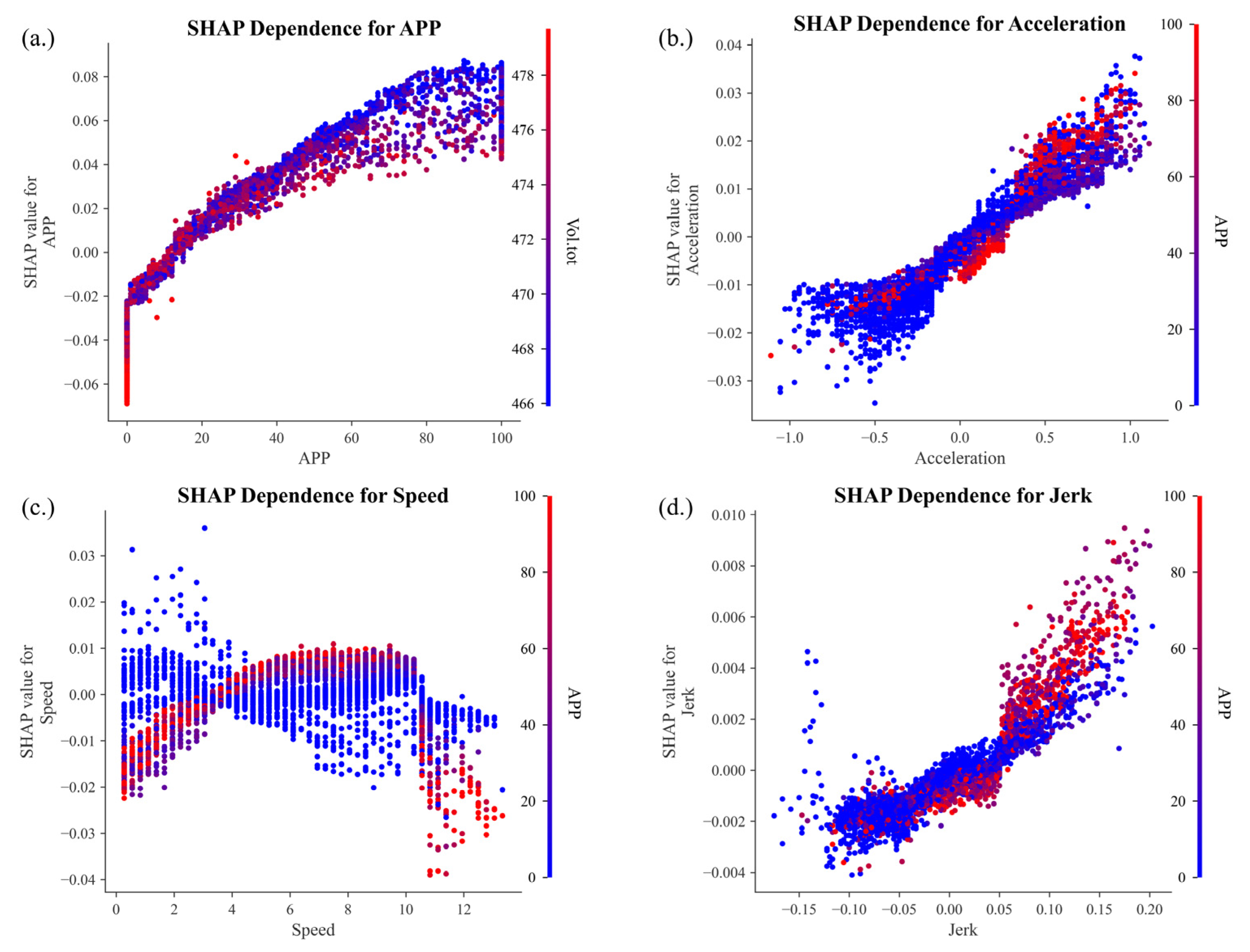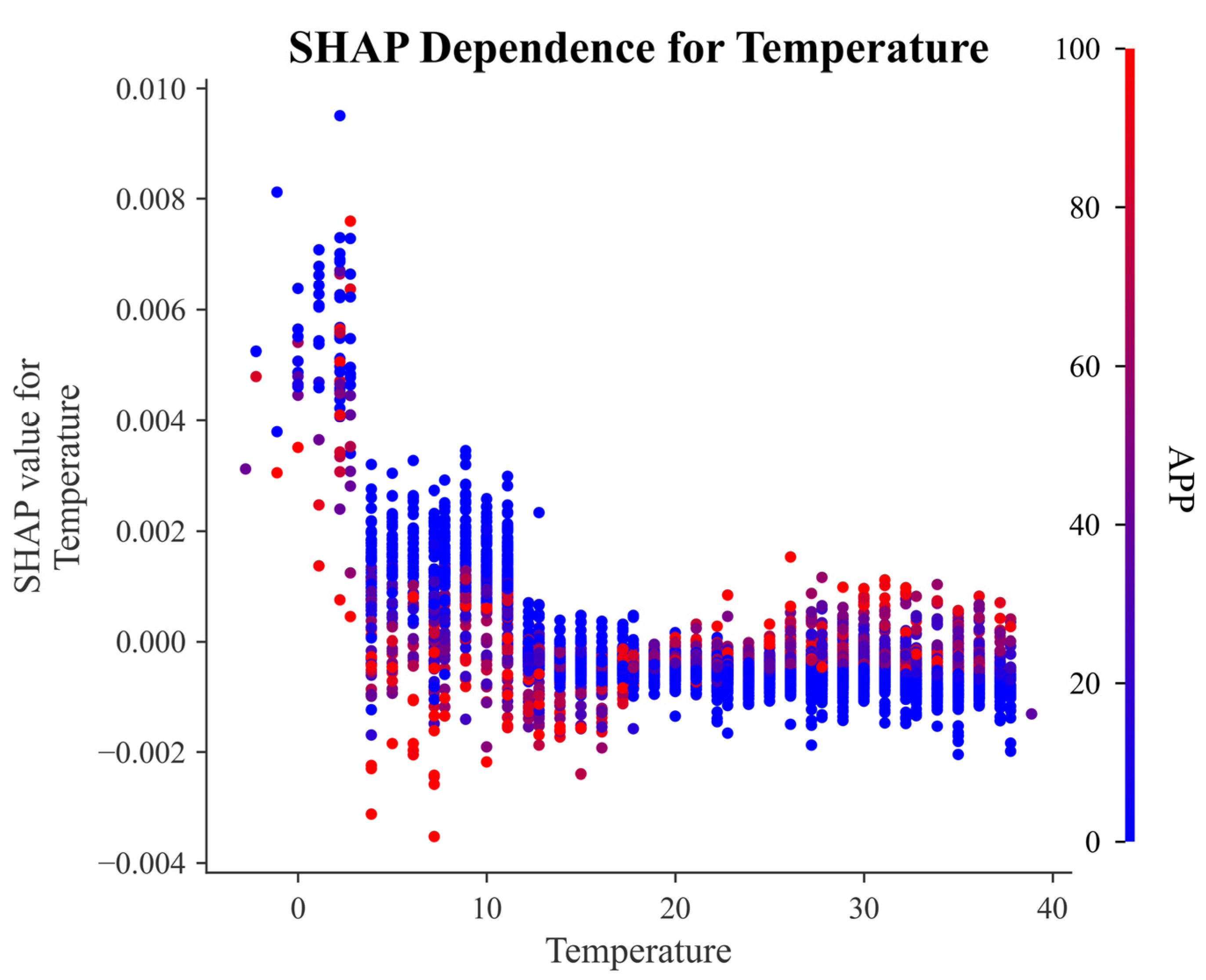1. Introduction
With the intensification of global climate change, governments in different countries are placing increasing emphasis on carbon emission reduction. The demand for energy conservation and emission reduction in transportation systems has become increasingly urgent [
1]. As one of the primary contributors to global energy consumption and carbon emissions, the transportation system plays an important role in environmental sustainability initiatives. To mitigate environmental pressures, many countries have introduced policies to promote green transportation, recognizing it as a key strategy for addressing climate challenges, and as a result, the adoption of electric vehicles (EVs) has emerged as a cornerstone solution [
2]. This policy focus has elevated EV development to a national strategic priority, and it is projected that by 2025, EV sales will exceed 20 million units, accounting for over a quarter of global automobile sales [
3]. While the widespread adoption of EVs contributes to carbon emission reduction, air quality improvement, and green transformation of the transportation system, several challenges and limitations persist, including battery range constraints and infrastructure integration issues [
4]. Consequently, energy consumption management and range prediction have emerged as critical research areas [
5]. EV energy efficiency is influenced by multiple complex factors, including vehicle and system operational status [
6], driving behavior [
7], climatic conditions [
8], and road conditions [
9]. A key challenge is minimizing energy consumption and improving operational efficiency without compromising vehicle performance. In this regard, accurately predicting battery energy consumption and analyzing its influencing factors is particularly important, as the battery—the core component of EVs, directly determines the vehicle’s range and operational efficiency. Through precise battery energy consumption prediction, energy waste can be reduced and battery utilization improved, and the battery’s lifespan can also be extended, thereby lowering the vehicle’s operational costs. A comprehensive analysis of various factors affecting battery energy consumption, such as driving behavior, climatic conditions, and battery system status, can help operational departments formulate more accurate energy optimization strategies. Furthermore, accurate energy consumption prediction facilitates more precise vehicle range estimation, which helps alleviate drivers’ range anxiety and enhances their driving experience. From an environmental perspective, reducing battery energy consumption can effectively decrease the overall carbon emissions of EVs and promote the development of greener and more efficient EVs. Therefore, battery energy consumption prediction is not only a key factor in enhancing the economic viability and market competitiveness of EVs but also a necessary means of achieving sustainable transportation and environmental protection goals.
In the prediction and estimation of energy consumption in EVs, existing research has primarily employed two methods: vehicle model-based and data-driven methods. The vehicle model-based approach relies on dynamic models, which are mainly categorized into forward and backward models. Forward models predict the vehicle motion state using driving inputs, such as throttle and brake conditions, steering angle, and other control variables. These models are widely used in industrial simulation software and have become the foundation for several commercial simulation models. In contrast, data-driven methods bypass the reliance on vehicle-specific parameters by directly utilizing the real operational data of vehicles and integrating the factors influencing energy consumption into machine learning models to predict battery energy consumption under complex influencing mechanisms. These methods leverage the powerful data-fitting capabilities of machine learning models, enabling them to handle more complex system features without requiring detailed vehicle parameters, and have gained significant attention in recent years. Although both methods have been applied in their respective fields, several key issues remain unresolved. (1) Vehicle model-based methods offer strong interpretability and can determine the contribution of various factors to energy consumption; however, some vehicle parameters are restricted by manufacturers’ confidentiality agreements, severely limiting the modeling of certain vehicle types. Additionally, when employing vehicle model-based methods for modeling, researchers are often only able to model a specific vehicle model [
10,
11], hindering broader applications across different vehicle types. Furthermore, some researchers have used auxiliary power models based on specific environmental temperatures and test vehicles that have undergone thermal preprocessing [
12]. This implies that the validity of these models may be limited by environmental temperature and the type of test vehicle, rendering them unsuitable for widespread application across all EV types and environmental conditions. (2) Data-driven methods, which construct feature engineering based on real vehicle operation data, have been widely used by many researchers to predict the energy consumption of EVs [
13,
14,
15]. While this approach has strong data-fitting capabilities, the “black box” nature of machine learning models leads to a lack of interpretability, which limits their transparency and reliability in practical applications. Therefore, balancing the predictive power and interpretability of the model remains a critical challenge in energy consumption prediction and estimation. (3) Currently, only a limited number of studies have focused on the impact of battery operating parameters on battery energy consumption [
6], which hinders a comprehensive understanding of how the internal operating states of battery systems affect energy usage. Existing research has indicated that power management is closely related to the performance of EVs [
16], and some studies have shown that monitoring battery parameters, such as controlling the temperature, is critical for achieving optimal battery operation [
17,
18]. Against this background, exploring the relationship between battery operating parameters and energy consumption is particularly important, as it may provide a systematic theoretical foundation for improving the energy efficiency of electric buses.
To address the above research gaps and challenges, this study proposes a framework that integrates stacking models, surrogate models, and SHAP analysis to predict the operational energy consumption of EVs and conduct an interpretability analysis. The main contributions of this study are as follows:
- (1)
The ampere-hour integration method was introduced to reconstruct the SOC precision and improve the accuracy of the energy consumption computation [
19].
- (2)
Battery operating parameters were incorporated into the feature set, together with driving characteristics and environmental factors, to construct a more comprehensive system of influencing factors for energy consumption, thereby providing a broader perspective for the subsequent analysis of energy consumption determinants.
- (3)
At the modeling level, a unified framework integrating a two-layer stacking model, surrogate model, and SHAP analysis is proposed to achieve a balance between the high-accuracy prediction of EV energy consumption and interpretability of its underlying mechanisms.
- (4)
A nonlinear interpretability strategy was developed using the SHAP model to analyze how changes in key indicators affect battery energy consumption, providing deeper insights for formulating more precise energy control strategies and policies.
The remainder of this paper is organized as follows.
Section 2 reviews the key factors influencing battery energy consumption and examines the methodologies employed in previous studies.
Section 3 describes the construction of the indicator system for battery energy consumption, including an overview of the study area and data sources.
Section 4 elaborates on the research methodology, detailing the process of fitting and interpreting the battery energy consumption impact mechanisms using the stacking model—surrogate model—SHAP framework.
Section 5 presents the model fitting results and an exploratory analysis of the factors influencing battery energy consumption.
Section 6 summarizes the key conclusions of this research.
2. Literature Review
In recent years, there has been a significant increase in research on battery energy consumption prediction and analysis of the influencing factors for EVs. Scholars generally select influencing factors from aspects such as battery system parameters, driving characteristics, environmental conditions and route characteristics. Additionally, methods for predicting the energy consumption of EVs are generally classified into two primary categories: vehicle model-based methods and data-driven methods. Both approaches have been extensively studied and applied in recent research.
2.1. The Influencing Factors of Battery Energy Consumption
This section summarizes the factors selected for EV battery energy consumption prediction from four categories: driving characteristics, environmental conditions, route characteristics, and battery system parameters.
Driving characteristics have been widely recognized as significant factors influencing the energy consumption of new energy batteries and have been extensively applied in energy consumption prediction research. Under identical road, environmental, and vehicle conditions, variations in driving habits and behaviors can lead to differences in energy consumption values. Zhang et al. demonstrated in their analysis and prediction of EV energy consumption that battery energy consumption is highly correlated with driver behavior characteristics, particularly the speed and acceleration [
20]. He et al. analyzed the relationship between energy consumption reduction and acceleration time and found that controlling driving behavior, such as extending the acceleration time, is key to reducing energy consumption during acceleration, emphasizing the significant impact of driving behavior on EV energy consumption [
21]. Zhang et al. conducted an energy consumption characteristic analysis based on microscopic driving parameters and found that the energy consumption rate of EVs increases with higher instantaneous speed and acceleration [
4]. The driving characteristics reflected by the use of the accelerator and brake pedals also impact energy consumption. Moreover, during acceleration, the proportion of energy consumption exceeds that of deceleration because kinetic energy can be recovered and converted into electrical energy during coasting or braking [
22]. Lárusdóttir et al. conducted a comprehensive study on the energy consumption of various vehicle types, analyzing the impact of driving behavior and vehicle characteristics [
23]. They concluded that extreme acceleration behaviors significantly increase energy consumption, whereas moderate acceleration and stable driving speeds contribute to energy conservation [
23]. In addition to the aforementioned indicators, Huang et al. introduced the degree of accelerator pedal depression in an energy consumption prediction model based on driving behavior to intuitively assess driving characteristics, achieving an accuracy of 98%. Simulation results showed that differences in the degree and frequency of accelerator pedal depression among drivers significantly impacted battery energy consumption [
24].
Environmental factors are less frequently incorporated into related studies due to the challenges associated with their observation; however, existing research has demonstrated their significant impact on battery energy consumption. Vepsäläinen et al. introduced environmental factors into the energy consumption prediction of three bus routes in southern Finland using a linear model and achieved a prediction accuracy of 75%. The study found that ambient temperature is the most influential environmental factor contributing to energy consumption uncertainty [
8]. In their study on the sensitivity of EV propulsion power to environmental factors, Yi et al. highlighted that environmental variables, such as temperature and wind speed, have a profound impact on the overall energy consumption of EVs and significantly affect the remaining range of the vehicle [
25]. In developing an energy consumption model for electric buses and optimizing the charging schedule, Gao et al. incorporated special conditions, such as rainy weather, into the model and considered humidity levels as a critical environmental variable [
26]. Ambient temperature has been consistently identified as the primary environmental factor influencing battery energy consumption [
27]. However, research on the effects of other environmental variables, such as humidity and air pressure, remains limited.
Building on the above, some studies have classified the factors influencing battery energy consumption into internal and external factors. For external factors, in addition to environmental variables, some studies have incorporated route characteristics into the indicator system, typically measuring these characteristics based on the number of bus stops and traffic lights along a route. For instance, Gallet et al. emphasized the role of bus stops in estimating the energy demand of electric buses [
28]. Their longitudinal dynamics model effectively utilizes low-resolution operational data, such as bus arrival and departure times at each bus stop, to accurately calculate energy demand, revealing that the heterogeneity of driving conditions leads to significant variance in energy requirements across different routes and at different times of the day. It also demonstrates the good potential for fast charging during layover times by quantifying the energy demand of bus routes between stops. Similarly, El-Taweel et al. introduced trip length and the distance between consecutive bus stops as key indicators in their energy consumption model while modeling bus routes in regions such as Brampton, Canada. They generated speed profiles to reflect real-world traffic conditions and speed behaviors for energy consumption modeling [
9]. Regarding internal factors, existing research primarily focuses on driving characteristics, with some studies incorporating the internal parameters of the vehicle battery system into the indicator framework. For example, Wu et al. considered the voltage, current, and resistance of a battery pack when estimating the instantaneous power and trip energy consumption of EVs [
6]. Fotouhi et al. incorporated SOC-related indicators into battery energy consumption estimation [
29]. The introduction of these battery system parameters helps shift the analytical perspective of battery energy consumption toward the vehicle’s battery system, offering new insights into battery system design and the development of energy-efficient EV models.
2.2. Predictive Methods
This section reviews the two primary predictive methods for estimating the battery energy consumption in EVs: vehicle model-based and data-driven methods, each with its strengths, limitations, and applications in energy consumption prediction.
Vehicle model-based methods have been widely applied in simulation software. For instance, Cioroianu et al. developed an EV model and simulated the energy consumption of the Dacia Sandero using AVL Cruise software, obtaining an average energy consumption result of 15.19 kWh/100 km [
30]. Similarly, the Argonne National Laboratory developed a vehicle simulation tool called Autonomie, which, in simulations of hundreds of thousands of vehicles, demonstrated that the prediction error fell within ±3% of the observed values. This simulation tool has become a standard tool for analyzing vehicle energy consumption [
31]. Backward models often utilize Longitudinal Dynamics Models (LDM) and Vehicle Specific Power (VSP) models, both of which have extensive applications [
20]. For example, Wu et al. developed an LDM-based model to estimate energy consumption by incorporating the vehicle speed, acceleration, road slope, and other driving parameters. In the energy consumption prediction for over 40 trips, the average MAE for all journeys was 15.6% [
6]. Fotouhi et al. integrated a vehicle model, driver model, and terrain model to develop an energy consumption estimator with an estimation error of less than 3% in field tests on specific routes [
29]. Zhang and Tian developed a vehicle-driven energy consumption prediction model by analyzing vehicle performance, extracting road features, and calculating wheel forces under varying road conditions. Simulation results showed that after a hybrid vehicle traveled more than 60 km, its power consumption dropped to below 1 kW [
32]. Although vehicle model-driven methods are widely applied and offer strong interpretability compared with data-driven models, they require a large number of vehicle-specific parameters during the modeling process, which may be constrained by vehicle type variations and proprietary parameter confidentiality.
Data-driven methods, which can be directly modeled using vehicle operation data, have garnered increasing attention from scholars in recent years. Zhang et al. developed a prediction framework based on the XGBoost model. In the application of energy consumption prediction for electric taxis in Beijing, the RMSE and MAPE were reduced by 32.05% and 30.14%, respectively [
20]. Grubwinkler et al. developed an SVM model based on crowdsourced data to predict segment-level energy consumption in EVs, achieving a relative average prediction error of less than 6.7% [
13]. Wang et al. used a gradient boosting model to predict the energy consumption of hybrid vehicles. The model achieved an average Pearson correlation of 0.741 through cross-validation, demonstrating high accuracy and strong robustness [
33]. Nan et al. used an LSTM-XGBoost model to predict the instantaneous energy consumption of electric buses, demonstrating strong time series forecasting and regression capabilities, with an RMSE of 0.079 and an MAE of 0.086 [
34]. Ziółkowski et al. developed an MLP-based neural network model to predict fuel consumption of passenger cars [
35]. The prediction results showed that the linear Pearson correlation coefficient between the predicted and actual values was 0.93–0.95 [
35]. Modi et al. designed a multi-channel Convolutional Neural Network (CNN) that uses speed, road elevation, and battery SOC as input features for energy consumption prediction, achieving a minimum mean absolute percentage error of 1.57% [
14]. Li et al. developed an energy consumption prediction model that combines RNN and DNN, achieving a MAE of 0.074682 when predicting energy consumption using vehicle state characteristics and other operational data [
15]. Yao et al. proposed a large-scale learning and prediction algorithm (LSLPP), a machine learning method for calculating energy consumption across different vehicle types, with the normalized RMSE for all experimental vehicles being less than 0.8% [
36]. Existing research has demonstrated the strong data-fitting capabilities of data-driven methods. However, due to their “black box” nature, these models lack interpretability compared to vehicle model-driven approaches, posing a significant limitation in practical applications.
5. Result Analysis
5.1. Statistical Characteristics of Data
Figure 5 illustrates the spatial distribution of battery energy consumption and its influencing factors.
Figure 5a,b illustrate the distribution of battery energy consumption, revealing that the data exhibit characteristics of a normal distribution, primarily concentrated around zero. Most samples exhibit energy consumption values close to zero, suggesting that vehicles predominantly operate in a low-energy consumption state during operation or under various conditions. As depicted in the histogram and violin plot, data frequency is highest around zero and gradually decreases as energy consumption values deviate from zero. The rightward extension of the kernel density estimation (KDE) curve suggests occasional periods of significant fluctuations in battery energy consumption. These higher energy consumption values, although less frequent, correspond to specific conditions in which the battery operates under high load or experiences abnormal functioning, resulting in a substantial increase in energy consumption. The occurrence of negative energy consumption on the left side of the distribution, although less frequent than that on the right side, suggests that vehicles may recover energy via the regenerative braking system under specific conditions.
Figure 5c–e presents the descriptive statistics of the factors influencing energy consumption, with all variables standardized prior to the analysis to ensure dimensional consistency. In terms of driving characteristics, Speed and Acceleration exhibited relatively dispersed distributions, indicating considerable variability among the samples, whereas APP demonstrated a more concentrated distribution, suggesting smaller fluctuations. Temperature and humidity exhibited relatively symmetric distributions. In contrast, wind speed displayed a distinctly multimodal distribution that gradually narrows at both ends, indicating that extremely high or low wind speeds occur less frequently. Regarding battery parameters, Vol. tot has a wide distribution range, suggesting significant fluctuations in the battery load over different time periods. Vol. mean also exhibits a broad distribution, while Vol. var remains relatively concentrated, implying that although the overall voltage level of the battery system varies considerably under different conditions, the voltage differences among individual sub-batteries remain relatively stable. Similarly, both Tem. mean and Tem. var indicate substantial temperature variations under different operating conditions, while the internal temperature differences among the sub-batteries remain stable. Tem. max and Tem. min exhibited broad and symmetric distributions, suggesting significant variations in the extreme battery temperatures across different scenarios. IR remains relatively concentrated for most of the time; however, its wide range of fluctuations implies that the battery’s insulation resistance may undergo considerable variation under different operating states.
5.2. Hyperparameter Optimization and Prediction Performance Comparison
To enhance the predictive performance and generalization ability of both the stacking and surrogate models, a two-stage hyperparameter optimization strategy was adopted in this study. In the first stage, a grid search combined with 5-fold cross-validation was applied to each of the three base learners in the first layer of the stacking model to determine the optimal values of n_estimators, max_depth, and learning_rate. In the second stage, the surrogate model was also tuned using a grid search with 5-fold cross-validation, targeting the optimization of n_estimators, learning_rate, max_depth, and the subsampling ratio subsample. The final optimal parameter configurations are listed in
Table 5.
To comprehensively evaluate the fitting accuracy of the model for battery energy consumption prediction, this study employs three widely used statistical metrics: mean squared error (
MSE), mean absolute error (
MAE), and root mean squared error (
RMSE), with their respective calculation formulas defined in Equations (11)–(13). Among them,
MSE and
RMSE apply a squared transformation to the error terms, assigning greater weight to larger deviations, thereby making the evaluation more sensitive to instances with high errors. In contrast, the
MAE calculates the average of the absolute deviations between the predicted and actual values, offering results with clear physical meaning and ease of interpretation. By incorporating both absolute and squared error metrics, this study evaluates the model’s accuracy and robustness from multiple perspectives, providing a solid foundation for formulating subsequent energy management strategies.
To further validate the effectiveness of the proposed stacking model, it is compared with several representative models. Specifically, the base learners of the stacking model included various ensemble algorithms, such as RF, CatBoost, and GBDT. These models, as typical representatives of machine learning approaches, demonstrate strong generalization capabilities in similar prediction tasks. In addition, deep learning models such as CNN and RNN have been widely applied in the field of energy consumption prediction in recent years; therefore, selected deep learning models are also included for comparison. By evaluating the performance of the stacking model against both traditional machine learning models and state-of-the-art deep learning approaches, this study aims to provide a comprehensive assessment of the predictive advantages and robustness of the proposed method.
As shown in
Table 6, the stacked model outperforms all baseline models, achieving the lowest
MSE (0.0020),
RMSE (0.0444), and
MAE (0.0241). This demonstrates that the stacking framework, which integrates multiple base learners through a meta-model, offers superior predictive accuracy and generalization ability. Moreover, the surrogate model—trained to approximate the output of the stacked model—achieves nearly identical performance, indicating its strong ability to replicate the behavior of the ensemble. Compared with conventional machine learning and deep learning models, the stacked model and its surrogate show clear advantages across all evaluation metrics, confirming the effectiveness of the stacking strategy.
5.3. Overall Feature Contribution Analysis
To analyze the impact mechanism of various influencing factors on battery energy consumption, this study applies the SHAP framework to evaluate both the direction and magnitude of each factor’s effect on the dependent variable.
Figure 6 presents the feature importance scatter plot and bar chart generated using the SHAP model.
Figure 6a shows the distribution of the SHAP values for each feature across all samples. The color represents the feature value for each sample (red indicates high values and blue indicates low values), while the horizontal spread of the points reflects the degree to which each sample influences battery energy consumption. This plot also reveals the overall direction of each feature’s effect on the target variables.
Figure 6b ranks the features by importance and presents their average impact on battery energy consumption, which is quantified by the mean absolute SHAP value. By jointly analyzing both plots, we can assess not only the relative importance of each variable but also the direction of its influence, providing an intuitive understanding of the internal mechanism of the stacking model.
Based on the above results, this study quantified the overall relative importance of the three major categories of features in relation to battery energy consumption, as shown in
Table 7. In addition, to focus on the most representative influencing factors, the study extracted the relative importance of the ten most impactful features, as shown in
Figure 7. The percentage values in the figure indicate the relative contribution of each feature to the model’s prediction, while the colors represent the categories to which the features belong. These features contribute most significantly to the model output and play a dominant role in determining the battery energy consumption. Analyzing these key features enables a more targeted understanding of the underlying mechanisms and provides recommendations for optimizing energy efficiency.
In the model, battery system indicators exerted the most substantial influence on energy consumption, with a cumulative contribution of 56.5%. From a macro perspective, Vol. tot is one of the primary driving factors, contributing −28.32% in total and ranking second among all variables. Vol. mean contributes 22.33%, indicating that higher average voltage levels lead to increased energy consumption. This suggests that while a moderate overall voltage level supports energy efficiency, an excessively high average voltage may hinder energy consumption control. Vol. var, which contributed 3.62%, underscores the importance of regulating the internal voltage distribution differences within the battery system. The IR contributed −0.71%, implying that strong insulation performance helps suppress leakage losses and enhances the overall system efficiency. Tem. var, with a contribution of 0.57%, further indicates that an uneven temperature distribution can intensify localized thermal effects, leading to increased energy consumption and underscoring the need for effective thermal management. Overall, maintaining an appropriate total voltage level, improving voltage stability, ensuring reliable insulation performance, and optimizing thermal management strategies are key measures for reducing the energy consumption.
Driving characteristics significantly impact battery energy consumption. Among them, APP (30.92%), acceleration (6.38%), speed (−4.01%), and jerk (1.02%) are the major contributing features, collectively accounting for 42.3% of the total contribution. This result indicates that aggressive acceleration and unstable driving behaviors notably increase energy consumption. Specifically, APP ranks first among all features in terms of contribution, highlighting its critical role as a driving factor of battery energy usage. A higher APP value reflects more intense acceleration behavior, requiring the battery to deliver a higher power output to meet driving demands, thereby increasing energy consumption. Similarly, increases in acceleration and jerk intensify the instantaneous power demand, elevate the battery load, and accelerate energy loss. In contrast, the negative contribution of speed suggests that maintaining a moderate and stable driving speed improves battery system efficiency and reduces energy consumption. Overall, these findings underscore the importance of optimizing driving behavior and minimizing abrupt operations to enhance the energy efficiency.
Environmental data contribute a total of 1.2% to battery energy consumption, with temperature being the only environmental factor among the top ten features, contributing −0.58%. This result suggests that although environmental factors have a limited overall impact, temperature still plays a positive role in reducing battery energy consumption. Favorable ambient temperatures help decrease internal battery resistance and improve charging and discharging efficiencies, thereby reducing energy demand to some extent. These findings highlight the important role of temperature in optimizing the operating conditions of batteries.
5.4. Variables Association Analysis
Section 5.3 provides an intuitive illustration of the average contribution of each feature to battery energy consumption, which facilitates the identification of key influencing factors. However, it does not capture how variations in feature values affect the direction and magnitude of their contributions. In real-world driving scenarios, feature variables often exhibit nonlinear influence patterns and complex interactions, making average contribution values insufficient for revealing their dynamic behavior. Therefore, this study introduces SHAP dependence plots to depict the marginal impact trends of key variables across different value ranges, thereby offering a more comprehensive understanding of the factors that affect battery energy consumption. In the SHAP dependence plots, the horizontal axis represents the independent variable influencing battery energy consumption, with units consistent with those in
Table 4. The vertical axis indicates the extent of the variable’s impact on the battery energy consumption, expressed as the SHAP values. Since SHAP values reflect the relative contribution of each feature to battery energy consumption, they are presented as unitless standardized explanatory metrics. In addition to visualizing the relationship between SHAP and feature values, the SHAP dependence plots also display, on the secondary vertical axis, the variable that exhibits the strongest interaction with the current feature along with its corresponding value, thereby facilitating the analysis of how feature interactions affect energy consumption.
Figure 8 illustrates the marginal effects of four battery system parameters, Vol. tot, Vol. mean, Vol. var, and IR, on battery energy consumption using SHAP dependence plots, along with their interactions with key auxiliary features. The SHAP dependence plot for Vol. tot shows a clear negative correlation. The SHAP value transitions from positive to negative at approximately Vol. tot ≈ 473, indicating that when the total voltage is below this threshold, it contributes to increased energy consumption, whereas beyond this point, it helps to suppress the energy use. Furthermore, the interaction effect reveals that higher values of Vol. mean on both sides of the threshold tend to dampen the impact of Vol. tot on energy consumption—pulling the SHAP values toward zero. This suggests a moderating effect, where Vol. tot and Vol. mean jointly influence energy consumption in a compensatory way. Vol. mean exhibited a positive correlation with the SHAP values, with the SHAP value crossing zero at approximately Vol. mean = 3.28, indicating this point as a critical threshold where the contribution to energy consumption shifted from negative to positive. The interaction effect with APP is particularly prominent, and higher APP values tend to weaken the influence of Vol. mean on battery energy consumption, pulling the SHAP values closer to zero. Vol. var shows an overall upward trend in its SHAP values, with a marked increase observed when Vol. var exceeds 0.001, indicating that greater voltage fluctuations in this range lead to significantly higher energy consumption. When Vol. var is below 0.001, the SHAP values change more gradually but exhibit two distinct inflection points, suggesting a more complex nonlinear impact on energy consumption in this interval. Nonetheless, Vol. var values below 0.001 are generally associated with a suppressive effect on energy use, which provides meaningful insights for designing energy control strategies at the battery system level. APP is again identified as the most significant interacting variable. When Vol. var < 0.001, higher APP values tended to shift the SHAP values from negative to positive, indicating increased energy consumption. Conversely, when Vol. var > 0.001, higher APP values tended to suppress the increase in SHAP values, thereby mitigating the negative impact of voltage variance. IR exhibits a typical pattern of diminishing marginal effects, with its SHAP value generally decreasing as IR increases. However, this downward trend is non-linear, showing a distinct “steep-then-gradual” pattern. Notably, IR ≈ 5000 corresponds to a turning point in the rate of SHAP value change, indicating a critical threshold at which the marginal impact intensity begins to shift. In addition, IR ≈ 10,650 marks the point at which the SHAP value crosses zero, signifying a change in the direction of IR’s influence on energy consumption—from a slight positive contribution to a negative (i.e., suppressive) effect. These two critical points represent the inflection of IR’s marginal effect and the directional shift in its impact, offering valuable insights into the relationship between the insulation condition of the battery system and its energy performance.
Figure 9 shows the SHAP dependence plots of the key driving-related features. The SHAP value for APP shows a monotonically increasing trend, with the rate of increase gradually slowing as APP rises. The SHAP value crosses from negative to positive at approximately APP ≈ 15, indicating that in the low throttle range, the APP has little to no impact on energy consumption and may even exert a slight suppressive effect. However, once the APP exceeds this threshold, it contributes significantly to increased energy consumption. Vol. tot demonstrates the most prominent interaction with APP. Notably, when the APP exceeds 50, higher Vol. tot values are associated with reduced SHAP values, suggesting that an elevated total voltage can mitigate the energy consumption impact of aggressive throttle inputs in higher APP ranges. The SHAP value for Acceleration exhibits an overall linearly increasing trend, transitioning from negative to positive around Acceleration ≈ 0. This indicates that positive acceleration is a major contributor to the increased energy consumption. In terms of interaction effects, the APP emerged as the primary interacting variable, with a pronounced amplification effect observed, particularly in the region where Acceleration > 0.35. In this range, higher APP values significantly increase the SHAP values of Acceleration, thereby reinforcing its positive contribution to energy consumption. This trend suggests that aggressive acceleration behavior driven by high APP inputs results in heightened energy sensitivity and elevated consumption risk. Accordingly, this region can be regarded as a critical intervention zone for energy management and control. Implementing measures to limit aggressive driving behavior or promote smoother acceleration in this region could effectively enhance overall energy efficiency. The relationship between Speed and SHAP value exhibits a parabolic pattern—initially increasing and then decreasing—with significant differences in interaction effects across various speed ranges. Specifically, in both the low-speed range (approximately 0–4 m/s) and the high-speed range (above 10 m/s), lower APP values are associated with higher SHAP values. In the moderate speed range (approximately 4–10 m/s), SHAP values remain at a relatively high level, and higher APP values further amplify the SHAP values. This trend indicates that aggressive driving behavior significantly intensifies the energy consumption within the moderate speed range. Jerk shows a positive correlation with SHAP values, indicating that the smoothness of driving behavior has a significant impact on energy consumption. The SHAP value increases notably when Jerk > 0, suggesting that sudden acceleration or unsteady driving substantially increases energy consumption.
Figure 10 illustrates the SHAP dependence of Temperature on battery energy consumption. Overall, Temperature exhibits a clear negative correlation with SHAP values. A critical threshold is observed at approximately 13 °C, where the SHAP value shifts from positive to negative. This indicates that lower ambient temperatures are associated with higher energy consumption during vehicle operation, which may be attributed to increased use of heating systems and changes in battery electrochemical activity under cold conditions. This finding highlights the importance of enhancing the adaptability of energy management strategies in low-temperature environments. In particular, incorporating temperature-aware energy consumption prediction and optimization mechanisms is essential to improve the operational efficiency and range stability of battery systems under varying climate conditions.
In summary, this section reveals the marginal contribution patterns and interaction effects of key features from three categories of data on battery energy consumption. By identifying the nonlinear influence pathways and critical threshold transitions of these features, the analysis facilitates a deeper understanding of how different variables affect energy consumption under complex operating conditions. Moreover, the findings provide a theoretical foundation for the development of future energy-optimization and control strategies.
6. Conclusions and Future Work
6.1. Conclusions
This study, based on a framework integrating stacking models, surrogate models, and SHAP analysis, predicts the operational energy consumption of electric buses and investigates the key influencing factors and their underlying mechanisms. The results show that battery operational parameters, driving characteristics, and environmental factors contribute 56.5%, 42.3%, and 1.2% to energy consumption prediction, respectively. Among them, battery parameters such as Vol. tot, Vol. mean, Vol. var, and IR have the most significant impact on energy consumption. In terms of driving characteristics, APP, Acceleration, Speed, and Jerk are identified as critical influencing factors. Among the environmental variables, ambient temperature exerts the most notable effect. This study also identifies the nonlinear influence patterns of these key features, which enhances the understanding of how they affect battery energy consumption and offers new perspectives for promoting energy conservation, emission reduction, and sustainable development in transportation systems. Based on the above findings, this study proposes the following optimization recommendations to improve the energy efficiency of electric buses:
- (1)
Optimizing the Battery Management System (BMS) to improve energy utilization efficiency. SHAP analysis reveals that a higher Vol. tot is significantly associated with lower energy consumption, particularly when Vol. tot exceeds 473, where the SHAP value tends to be negative, emphasizing the importance of maintaining a stable and efficient overall voltage level during operation. Meanwhile, the positive contributions of Vol. mean and Vol. var indicate that controlling voltage fluctuations and ensuring voltage stability are equally crucial for controlling energy consumption. Specifically, when Vol. mean is below 3.28, the SHAP value is less than 0, indicating that the average voltage range is associated with lower energy consumption. When the Vol. var is below 0.001, the SHAP value is relatively low, suggesting that a more uniform voltage distribution helps reduce energy consumption. Additionally, IR is identified as a key variable, with its marginal effect indicating that when IR exceeds 10,650, the SHAP value becomes negative, highlighting the importance of improving insulation quality to enhance energy efficiency. Therefore, optimizing the BMS should go beyond mere passive state monitoring and incorporate proactive regulation and predictive control capabilities. Specifically, the BMS should implement dynamic voltage regulation strategies to ensure that Vol. tot and Vol. mean remain within energy-efficient operating ranges. Moreover, real-time monitoring and rapid response mechanisms are beneficial for mitigating energy fluctuations related to Vol. var. Regular assessment of insulation conditions and timely identification of potential faults are also crucial for further ensuring the efficient, safe, and low-carbon operation of battery systems.
- (2)
Given the significant impact of driving characteristics on battery energy consumption, this study confirms that targeted adjustments to driving behavior are essential for controlling energy usage. The results indicate that aggressive acceleration, characterized by high APP values, significantly increases energy consumption, whereas smooth acceleration and moderate throttle input can effectively alleviate this burden. The positive correlations between Acceleration, Jerk, and energy consumption further suggest that gradual speed changes and smooth velocity transitions help reduce energy demands during dynamic driving conditions. These findings underscore the necessity of employing intelligent driver-assistance systems to suppress extreme driving behaviors, such as sudden starts and stops, thereby enhancing overall driving stability and facilitating energy control. Additionally, the adverse impact of high APP values within the moderate-speed range should not be overlooked. In conclusion, refined management of driving behavior can significantly reduce the operational energy consumption of electric buses and support the development of more sustainable urban transportation systems.
- (3)
The study finds that among various environmental factors, temperature is one of the primary variables affecting battery energy consumption, with its impact being particularly evident under extreme climate conditions. Such extreme temperatures are typically associated with increased energy demand, especially due to the operation of auxiliary systems like air conditioning. The results highlight the importance of enhancing the energy adaptation capabilities of vehicles under these conditions. Specifically, optimizing the energy management strategy of the air conditioning system and implementing battery preheating mechanisms in low-temperature environments can help mitigate the negative effects of ambient temperature fluctuations on battery performance and the overall energy consumption of the vehicle.
6.2. Limitations and Future Work
Despite the valuable findings of this study, several limitations remain. First, the training process of the stacking model is relatively complex, requiring substantial computational resources and posing challenges for parameter tuning, which may limit its practical applications. Secondly, this study was validated only in Changsha, Hunan Province, China. Future research should consider extending model validation to a broader range of geographical regions or datasets to assess its generalizability under different geographic and climatic conditions. In addition, the indicator system constructed in this study still has room for further expansion. For example, vehicle load is an important factor that should be prioritized and incorporated into future indicator systems. However, due to data limitations, this study was unable to obtain the real-time load data of electric buses during operation. Although vehicle load does not directly affect speed, acceleration, or environmental variables, it can significantly influence motor load, thereby impacting overall energy consumption. Therefore, future research should consider incorporating real-time load and other supplementary data and gradually transition from the current offline testing to online testing, in order to further enhance the model’s accuracy and comprehensiveness in predicting energy consumption and analyzing its influencing mechanisms.
